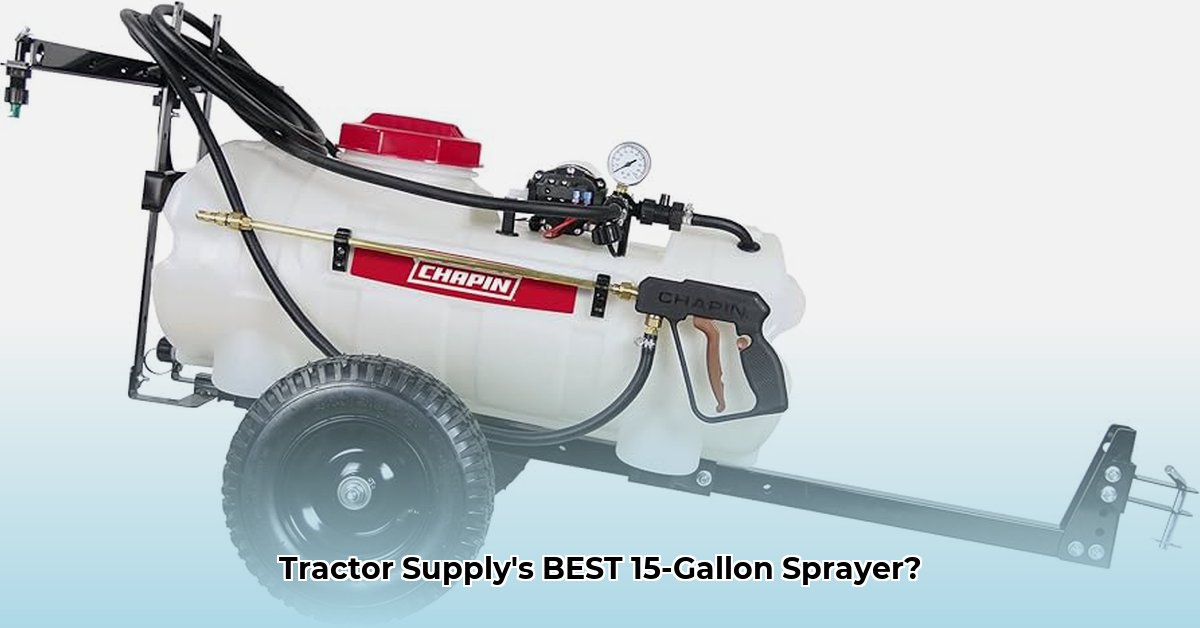
Finding the right 15-gallon sprayer for your small-scale farming operation can be challenging. Online information is often scarce, especially for specific Tractor Supply Co. models from brands like Fimco and Agri-Fab. This guide simplifies the process, helping you choose the best sprayer for your needs. We'll cover different sprayer types, crucial features, and effective research strategies to ensure you make an informed purchase.
Understanding Your Sprayer Options at Tractor Supply
Tractor Supply likely offers two main types of 15-gallon sprayers: handheld and tow-behind.
Handheld Sprayers: Ideal for Smaller Jobs
Handheld sprayers are perfect for smaller tasks like tending a backyard garden, a small orchard, or spot-treating weeds. Their portability is a major advantage, but their power might limit efficiency on larger areas. How much time are you willing to spend spraying?
Tow-Behind Sprayers: For Larger-Scale Operations
Tow-behind sprayers are the heavy lifters, designed for larger fields and more extensive spraying. They significantly increase efficiency but require a tractor or ATV and offer less maneuverability in tight spaces. Do you have the equipment to tow a larger sprayer?
Key Features to Consider When Choosing Your 15-Gallon Sprayer
Before buying, consider these essential features:
Tank Material: Most use durable plastics, but higher-end models may offer more corrosion-resistant materials like stainless steel (which stands up better to harsh chemicals and weather). What level of durability do you need?
Nozzle Types: Nozzles vary, producing different spray patterns (e.g., fine mist, concentrated stream). Consider the specific needs of your crops or target weeds. Does your application require a wide spray or a more focused stream?
Pressure Regulation: Consistent pressure ensures even coverage. Look for adjustable pressure settings for optimal control and efficient pesticide use. How crucial is consistent pressure for your spraying needs?
Ease of Cleaning: Thorough cleaning after each use prevents clogging and contamination. Features like wide openings and removable parts aid in efficient cleaning. How important is easy cleaning and maintenance?
Safety Features: Prioritize safety features like pressure relief valves and ergonomic handles for comfortable and safe operation. Is operator comfort and safety a high priority for you?
Where to Find More Information: Beyond Online Search
Reliable, detailed specs online are often hard to find. Here are more effective ways to gather information:
Contact Tractor Supply Directly: Call your local store; their staff often have expert knowledge and can provide personalized recommendations.
Visit a Tractor Supply Store: Inspecting the sprayers in person allows you to assess their build quality, ease of operation, and overall suitability for your needs.
Manufacturer Websites (Fimco & Agri-Fab): Check the manufacturer's websites for detailed specifications and user manuals.
Making Your Purchase: A Step-by-Step Guide
Set a Budget: Determine your maximum spending limit.
Assess Needs: How large is your area? What are you spraying? This dictates handheld vs. tow-behind.
Check Manufacturer Specifications: Carefully review tank capacity, nozzle types, and pressure capabilities.
Search for User Reviews: Look for reviews on forums or social media; these can offer valuable insights.
Maintenance and Safety: Best Practices for Responsible Spraying
Regular maintenance extends lifespan. Always:
- Clean thoroughly after each use, following manufacturer instructions.
- Store properly to prevent damage and corrosion.
- Handle pesticides with extreme care, wearing appropriate protective gear and strictly following label instructions.
Conclusion: Your Path to the Perfect Sprayer
Finding the best 15-gallon sprayer might require more research than a simple online search. By using the strategies outlined here, you'll ensure you select a sprayer that meets your needs and promotes safe, sustainable agricultural practices.